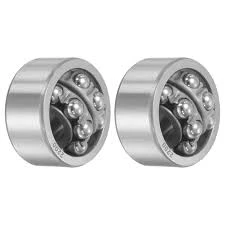
12 月 . 04, 2024 09:09 Back to list
double acting thrust bearing
Understanding Double Acting Thrust Bearings
In the realm of mechanical engineering, bearings play a critical role in facilitating the smooth operation of machinery and equipment. One notable type of bearing is the double acting thrust bearing. This specialized component is designed to accommodate axial loads in both directions, making it particularly useful in applications where forces can act from opposite directions.
What is a Thrust Bearing?
A thrust bearing is a type of bearing that allows for rotation while supporting axial loads. Unlike radial bearings, which manage loads perpendicular to the shaft, thrust bearings are built to handle forces that are parallel to the shaft's axis. This characteristic is crucial in applications such as automotive engines, gearboxes, and various machinery where axial loads are prevalent.
The Design of Double Acting Thrust Bearings
Double acting thrust bearings are designed with two sets of bearing surfaces that can support axial load in both directions. This configuration allows them to handle pushing forces from either side, proving invaluable in scenarios where reversal of load direction occurs. The typical arrangement includes two sets of rings the upper thrust ring and the lower thrust ring, each incorporating rolling elements, usually ball bearings or cylindrical rollers, to minimize friction and wear.
The design often features a cage to keep the rolling elements evenly distributed, enhancing the bearing's reliability and performance. Moreover, double acting thrust bearings can be made from various materials, such as steel, bronze, or composite materials, selected based on the application’s requirements, including load capacity, speed, and environmental conditions.
Applications of Double Acting Thrust Bearings
Double acting thrust bearings are ubiquitous in many industrial applications. Here are a few key areas where they are prominently used
1. Marine Propulsion Systems In ships, the propellers are often connected to shafts that rotate in both directions. Double acting thrust bearings ensure that the axial loads transmitted through the shafts are effectively managed, allowing for smooth and efficient operation.
double acting thrust bearing

2. Cranes and Lifting Equipment These bearings are essential in cranes, where they bear the loads from materials being lifted. As the load shifts during operation, the double acting design facilitates the necessary support in both axial directions.
3. Heavy Machinery Equipment such as excavators and bulldozers frequently experiences variable loads during operation. Double acting thrust bearings offer the necessary resilience to support the shifting forces.
4. Automotive Applications In transmissions or clutch systems, where forces may change direction rapidly, double acting thrust bearings provide reliable performance and durability.
Advantages of Double Acting Thrust Bearings
The unique design of double acting thrust bearings offers several advantages
- Versatility They can handle loads in both directions, making them applicable in a wide range of systems. - Reduced Friction The use of rolling elements reduces contact area, resulting in lower friction coefficients. This improvement in efficiency extends the lifespan of both the bearing and the equipment it serves. - Robustness These bearings are typically robust, designed to handle high loads and stressful environments, ensuring reliability over long periods.
Challenges and Considerations
While double acting thrust bearings offer numerous benefits, they also come with considerations. Proper lubrication is essential to minimize wear and heat buildup. Additionally, their installation must ensure precise alignment to prevent premature failure. Regular maintenance checks are crucial to ensure they are functioning correctly and to address any potential issues before they escalate.
Conclusion
In summary, double acting thrust bearings are fundamental components in the machinery sector, effectively absorbing axial loads from multiple directions. Their versatility, efficiency, and reliability make them essential in various applications, from marine propulsion systems to heavy machinery and automotive technology. Proper understanding and maintenance of these bearings can significantly enhance the performance and longevity of the equipment they support. As technology advances, we can expect to see further innovations in bearing design, tailoring them even more closely to the ever-evolving demands of modern engineering.
Latest news
-
Unlocking Efficiency with Spherical Roller Bearings
NewsOct.29,2024
-
The Ultimate Guide to Thrust Ball Bearings
NewsOct.29,2024
-
The Power of Thrust Roller Bearings: Engineered for Excellence
NewsOct.29,2024
-
The Power of Deep Groove Ball Bearings for Your Application Needs!
NewsOct.29,2024
-
The Power and Performance of Cylindrical Roller Bearings
NewsOct.29,2024
-
High-Quality Ball Bearing Manufacturing Machines
NewsOct.29,2024
